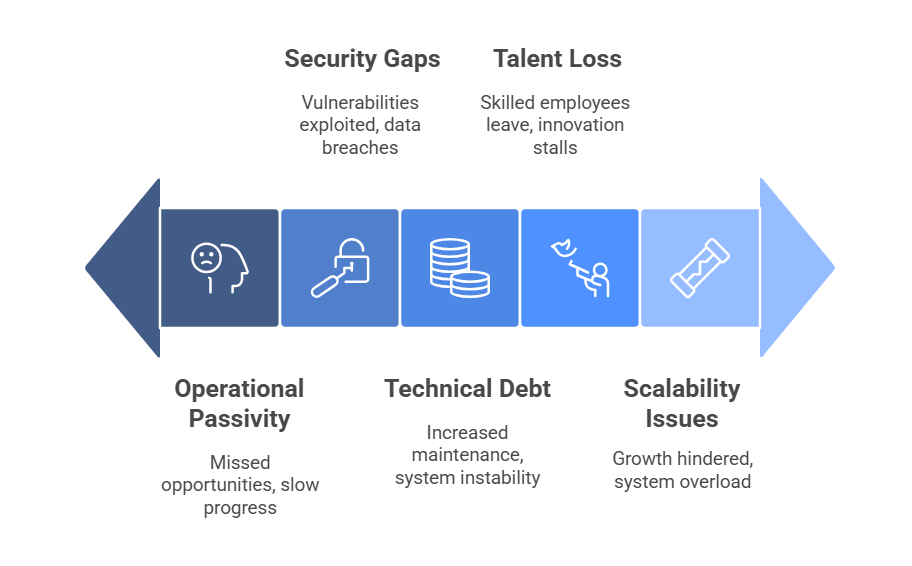- June 19, 2025
What may pose the biggest risk to a company may not be a cyber threat, nor a cloud migration delay. Rather, it may be the one legacy application, dusty in its old corner, that silently executes payroll or customer orders, stitched together through the decades with patches, and never enhanced since. Legacy system modernization is often postponed but this neglect can turn silent dependencies into serious vulnerabilities.
Over 80% of enterprises worldwide still depend on at least one legacy system for their core operations, asserts a 2023 IDC study. Even worse is this, 70% of an organization’s IT budgets are being drained by maintaining outdated infrastructure instead of funding innovation.
Such a state is not only inefficient; it constitutes a grave risk. Delays in the modernization of legacy systems have thus far been seen as technical choices, they now represent a business risk glaringly in the open.
Let us bring you clarity through this blog!!
The Risk You Didn't Plan
How One System Alone Could Be Your Biggest Issue and Nobody Is Talking About It?
Old systems are like drowning landmines in your tech landscape, not visibly instable on the surface, but explosive when you require agility, security, and integration. The impact of legacy systems is not technical, operational, customer-experience, and revenue-bleeding.
Old CRMs, inventory applications, or even financial tools invented decades before are still running on obsolete code bases. The legacy infrastructure they sit on is not slow and usually unsupported. It’s unscalable.
The Hidden Menace within Your Technological Stack
What Is Legacy System Actually?
Built-in Internet Explorer 6 or requiring manual workarounds, you might consider it a legacy application. But denial about age, it’s all those known issues-incompatibility and outdated techniques along with dwindling adoption that define it.
Lotus Notes apps, COBOL-based payroll systems in your company, or very antiquated Oracle forms.
Why Do Companies Still Continue with Them?
You probably have heard or spoken the phrase: “if it is not broken, then do not fix it.”
Most of them are terrified of data lock-in or integration nightmare challenges upon retirement of their old systems
But legacy infrastructure has a knack for hanging around a bit too long and causing legacy system challenges when you can at least afford them.
The True Cost of Inaction

Operational Passivity You Cannot Ignore: Outdated operating systems cannot keep up with real-time demand. They introduce delays, manual workarounds, and high costs per transaction efficiency.
Security Gaps and Compliance Nightmares: Most likely, executing outdated software means there is little or no vendor support or security patches. These pose enormous security problems, and with that comes the risk of failing audits.
Technical Debt That Guilts Everyone: You may spend upwards of five dollars to solve problems later for every dollar you save postponing the upgrade. Technical debt builds silently in IT systems, and it compounds.
The Loss of Good Talent to Outdated Technology: Nobody enjoys working on a platform reminiscent of the 90s. Outdated technologies have become a hurdle in hiring.
Scalability Moments when Time Gets Stuck: Want mobile access? Real-time analytics? Cloud sync? Good luck. Legacy systems choke on their own limitations when asked to perform beyond a small original scope.
Signs You're Sitting on a Ticking Time Bomb
5 Clues You’re at Risk
- Frequent system crashes
- No integration with cloud or SaaS tools
- Reports that take hours to generate
- You fail modern security audits
- You’re the only one left using it.
What Is Legacy System Modernization?
More Than a Tech Upgrade, It’s a Business Move!
System modernization isn’t just replacing legacy systems but aligning tech with business goals. Whether you rehost, replatform, refactor, or rebuild, modernization supports digital transformation and creates space for growth.
Today, businesses are moving toward cloud-native, Power Platform, and microservices-based architectures to replace monoliths. It’s not about shiny tech, it’s about staying competitive.
Roadmap to Modernization
Step 1: Audit Your Stack – Identify systems with the highest risk and lowest ROI.
Step 2: Prioritize for Impact – Start small. Go for visible wins.
Step 3: Quick Wins with POCs – Build confidence with low-risk, high-impact projects.
Step 4: Secure Buy-In from All Levels – Get alignment between IT and business.
Step 5: Choose a Strategic Modernization Partner – Modernization isn’t a DIY job.
Proven Approaches That Work

Which Path Should You Take?
Replatform: Lift-and-shift to cloud without rearchitecting.
Refactor: Redesign parts of the application.
Rebuild: Complete rewrite (expensive but future-ready).
Bonus: With Power Platform, SMBs can modernize apps fast using low-code tools
Overcoming the Reluctance
Why You’re Still Stuck and How to Break Free
Fear of downtime, tight budgets, or just too busy, these are valid but dangerous excuses. The truth is, overcoming legacy system challenges starts with awareness, then a phased plan.
Conclusion: Your Next 90 Days Start Now
Future-Proof or Fall Behind
Legacy system risk isn’t a future issue, it’s happening now. With security threats, downtime risks, and rising maintenance costs, waiting is no longer an option.
Happy Learning!!
Book a Free Legacy Assessment with HexaCorp Today.
Let’s map your system modernization journey together.
FAQs
What is a legacy system in business?
A legacy system in business is defined by an outdated software application that, despite having far superior, secure alternatives, is still being used in the daily operations of the institution.
What are the risks in the use of legacy systems?
An Abysmally low level of security, downgraded performance, low support, non-compliance-the above are some horrible things.
Why do companies refrain from upgrading their legacy system?
Hirings for fear of disruption, integration challenges, and injecting budget constraints into discussions remain the three most common culprits.
Distinguish system modernization from software re-engineering.
While modernization of a system can includes rehosting or replatforming, re-engineering involves the design of the app or construction of it from scratch.
What are some strategies that help with legacy systems challenges?
Starting with a risk-based evaluation, ranking systems based on ROI, and using POCs to evaluate solutions prior to promotion.
How would HexaCorp assist in modernization of legacy systems?
HexaCorp can provide modernization services from start to end, from auditing to execution, powered by the Power Platform, cloud-native tools, and tried-and-tested frameworks.




